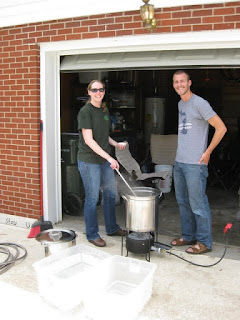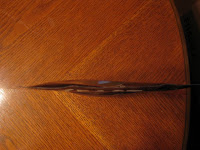| Time to light the fire. We used to do this on the stove but now use the "Bayou Classic" with a propane tank to brew with a full five-gallon boil. This was our first step toward all-grain brewing and should improve the quality of the beer versus adding 3 gallons of water at the end of the boil as we used to. |
 |
| Pour the grains into a mesh bag (provided with kit). |
 |
| Add the one gallon from inside to the four gallons heating outside. Bring to a boil for one hour...eat lunch while keeping an eye on the pot. You definitely want to avoid a boil over. No fun! |
 |
Fellow home brewers from Kirksville came over to join in the fun! Here I am about to pour in a hop addition. |
The Black IPA had 6 ounces of hops. The first addition was 1 oz. of Summit hops with an alpha of 18.75% for the entire 60 minutes of boiling. This should be one hoppy, bitter beer (in a good way). I'm very excited!! Hops are added at different times for different reasons throughout the boil. Those Summit hops were for bittering and therefore were added at the beginning. The Cascade and Centennial hop additions at the 15, 10, and 5 minute mark as we counted down from 60 minutes were for creating a nice citrusy, hop flavor. Then the 1 oz. at the 0 minute mark is for aroma. The final 1 oz. I'll dryhop it with in a few weeks will give that extra over the top kick of hoppiness.
 |
| The 0 minute hop addition |
The Extra Pale Ale had only 3 ounces of hops by comparison and will not be dryhopped.
 |
| Here you can see clear tubes coming out of the pot. |
When you are boiling beer it is called wort. It sounds lovely doesn't it? Anyway, these clear tubes are coming out of a wort chiller called Chillzilla. (Some of you met Chillzilla at our couple wedding shower in Iowa last summer). Our garden hose is hooked up to one end of this contraption and pumps cold water through a series of copper coils. The water in the coils warms and is pumped out the tubes at the other end pulling heat away from the wort. This is a critical stage in brewing where you want to cool the wort as fast as you can while also not exposing it to contaminants.
 |
| Brewing spectators |
 |
| More spectators and lovers of our homebrew |
We had a successful brew day with lots of support and lots of fun. Now we wait...in about a week and a half we'll siphon these beers into a secondary fermentation. Essentially put it a clean fermenting bucket. After another two weeks of fermenting we will siphon the beer into 5-gallon ball-lock kegs. We hook the kegs up to the CO2 tank in our four-tap kegerator and push gas through them for a couple days. After that the beer will be ready to drink so come pay us a visit!




No comments:
Post a Comment